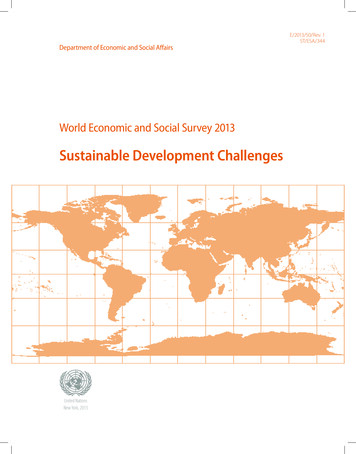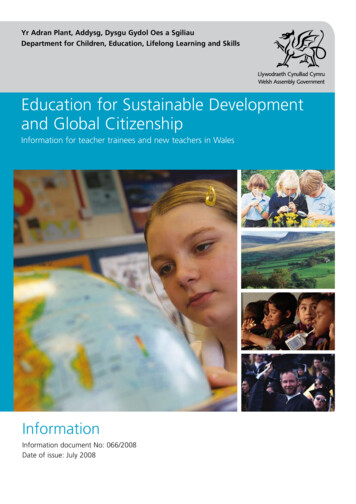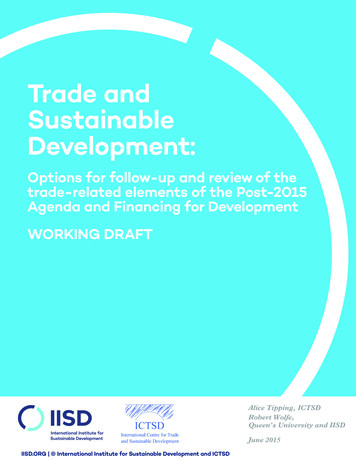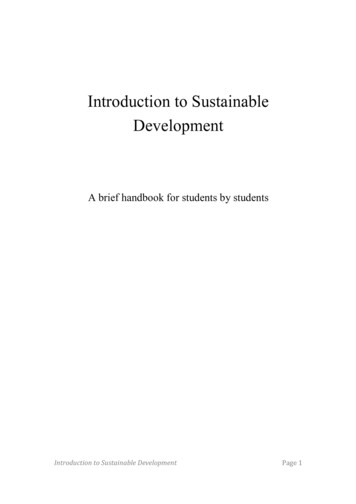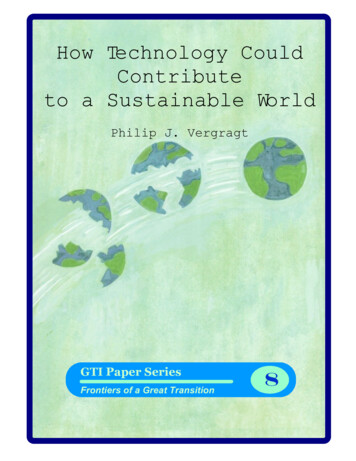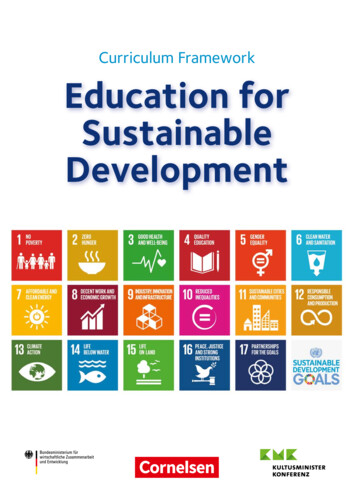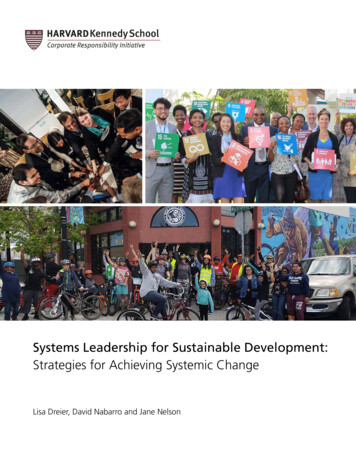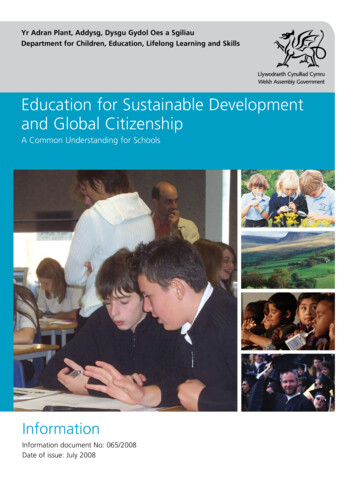
Transcription
Yr Adran Plant, Addysg, Dysgu Gydol Oes a SgiliauDepartment for Children, Education, Lifelong Learning and SkillsEducation for Sustainable Developmentand Global CitizenshipA Common Understanding for SchoolsInformationInformation document No: 065/2008Date of issue: July 2008
A Common Understanding for SchoolsAudienceHead teachers of all maintained schools in Wales1; local authorities;Teacher and other unions; teacher training institutions; nationaland local bodies in Wales concerned with education for sustainabledevelopment and global citizenship.OverviewThis is an information document to aid delivery of ESDGC in schools.The ‘Themes’ identified in the ‘Common Understanding’ cover therange of ESDGC and support the delivery of statutory Subject Orders,relevant frameworks, other relevant non-statutory frameworks andthe 14-19 Learning Core. This document also supports delivery of theWelsh Baccalaureate.ActionrequiredNo action required – For information onlyFurtherinformationAll enquiries about this information document should be sent to:Jane NettletonStrategy UnitDepartment for Children, Education, Lifelong Learning and SkillsWelsh Assembly GovernmentCathays ParkCardiff CF10 3NQTel: 029 2080 1402E-mail: esdgc@wales.gsi.gov.ukAdditionalcopiesFurther copies may be obtained at the above address.This document can also be accessed from the WelshAssembly Government website ls/policy strategyand planning/sustainabledevelop/?lang engRelateddocumentsESDGC action plan 2006ESDGC action plan updated January 20081 In this document ‘schools’ also includes all funded non maintained settings suchas nurseries. The term ‘teachers’ is used throughout the document torefer to all practitioners working with learners of any age.ISBN 978 0 7504 4770 6 Crown copyright July 2008CMK-22-07-306D1570809Thanks to rspb-images.com forproviding photo 2 on cover
ContentsSummaryWhat is Education for Sustainable Developmentand Global Citizenship?4The Welsh Context5A Whole School Approach to ESDGC6The Common Areas of ESDGCCommitment and LeadershipLearning and TeachingCase StudiesSchool ManagementPartnerships and CommunityResearch and Monitoring8101215171819AppendicesAppendix 1: ESDGC and Skill Development21Appendix 2: A framework of ESDGC acrossthe Key Stages25Appendix 3: S uggested guidance for evaluatingprogression in ESDGC45Appendix 4: Self Evaluation Tool48Appendix 5: From concepts to themes50ESDGC: A CommonUnderstanding for SchoolsJuly 2008Information DocumentNo: 065/20081
ESDGC: A CommonUnderstanding for SchoolsJuly 2008Information DocumentNo: 065/20082
SummaryThis is a guidance document to aid delivery of ESDGC in schools.The ‘Themes’ identified in the ‘Common Understanding’ coverthe range of ESDGC and support the delivery of statutory SubjectOrders, relevant frameworks, other relevant non-statutoryframeworks and the 14-19 Learning Core. This document alsosupports delivery of the Welsh Baccalaureate.The document builds on the desire expressed in the WelshAssembly Government document ‘Making the Most of Learning’(DCELLS, 2008) to deliver education that prepares students for“their lives in the 21st century and their role as global citizens”.This document outlines a common understanding and providesinformation, tools and case studies to enable schools to worktowards embedding ESDGC throughout.“Climate change,poverty, conflictand consumerpressure are allpart of our worldtoday ”“Climate change, poverty, conflict and consumer pressure areall part of our world today. ESDGC seeks to find ways to raiseawareness and action to address the consequences of our lifestylechoices” Jane Hutt, Minister for Children, Education, LifelongLearning and Skills - Education for Sustainable Development andGlobal Citizenship - A Strategy for Action, Updated January 2008.ESDGC: A CommonUnderstanding for SchoolsJuly 2008Information DocumentNo: 065/20083
What is Education for SustainableDevelopment and Global Citizenship?ESDGC is about:“Education is themost powerfulweapon you canuse to changethe world” Nelson Mandela“A goodeducation isbeing able tounderstand life”- Malcolm X:Freedom ThroughLearning to Read the links between society, economy and environmentand between our own lives and those of people throughoutthe world the needs and rights of both present and future generations the relationships between power, resources and human rights the local and global implications of everything we do and theactions that individuals and organisations can take in responseto local and global issues(Education for Sustainable Development and Global Citizenship:Why? What? How?, ACCAC 2002)Education for Sustainable Development and Global Citizenship(ESDGC) is education that will prepare young people for lifein the 21st century.However, ESDGC should not be seen as an additional subject.It is more than a body of knowledge as it is about values andattitudes, understanding and skills. It is an ethos that can beembedded throughout schools, an attitude to be adopted, a valuesystem and a way of life. ESDGC links the environment and thepeople who live in, and from, it. It looks at the world and the waysthat all living things relate to each other. It recognises that the worldis unjust and unequal, but that it can be shaped and changed bythe attitudes, values and behaviour of the people who populate it.ESDGC encourages and supports the development of thinking skills,and helps involve and engage young people in their own learning.The challenge for schools is to provide opportunities for teachersand learners to consider global issues; make links between whatis personal, local, national and global; engage in culturally-diverseexperiences; critically evaluate their own values and attitudes;and develop skills that will enable them to challenge injustice,prejudice and discrimination. This is ESDGC: embracing it hasthe potential to enhance and enrich education.ESDGC: A CommonUnderstanding for SchoolsJuly 2008Information DocumentNo: 065/20084
The Welsh Context“SustainableDevelopmentis not an optionthat will go away- it is the onlyway forward”(Rhodri Morgan,2004).Wales is a unique country, with its own culture, language andgovernment - a government that has a duty to promote sustainabledevelopment. This duty was defined under the Government of WalesAct 1998 and is still very much on the agenda.To be sustainable, Wales should promote an economy that makesminimal demands on the environment; take action on social justiceto tackle poverty, and ensure diversity and biodiversity to enhanceits communities. It should value its people and support them tolive healthy and interdependent lives. However these things cannotbe achieved in isolation and in order for Wales to be a sustainablecountry it must contribute at a global level. Wales plays an importantrole in NRG4SD (National Regional Governments for SustainableDevelopment) and has established global links through Wales forAfrica and the Gold Star Communities to strive to achieve theMillennium Development Goals.The Sustainable Development Action Plan 2004-7 identifiedESDGC as one of the Welsh Assembly Government’s top tenpriorities. In the same way that sustainable development underliesall Welsh Assembly Government’s policies, ESDGC was to becomean overarching theme for education in Wales.In September 2004 Estyn introduced a Common InspectionFramework that made it a requirement for all school inspectionreports to comment on ESDGC (a unique feature of the inspectionprocess in Wales). Guidance was provided for inspectors in‘Inspection Matters 2’ (Estyn, 2005) and this was updated in2006 following a baseline survey that showed a great disparityof delivery throughout Wales. Where schools were not engagingthe “main stumbling block seemed to be the lack of a clear viewof what ESDGC is about” (Susan Halliwell, Estyn 2008).In September 2006, ‘ESDGC A Strategy for Action’ was publishedby the Welsh Assembly Government providing actions necessaryfor all education sectors to enable the effective implementationof ESDGC. This highlighted the need for a ‘Champion’ to drivethe agenda and for a ‘Common Understanding’ to providea clear picture of ESDGC in Wales. This document was updatedin January 2008 to report on progress to date.ESDGC: A CommonUnderstanding for SchoolsJuly 2008Information DocumentNo: 065/20085
A Whole School* Approach to ESDGC“The real processof educationshould be theprocess oflearning tothink throughthe applicationof real problems.”- John DeweyIf it is to succeed, ESDGC needs to be addressed by the wholeschool community, not just teachers and learners, but parents,carers, governors, visitors and non-teaching staff. To be effectiveESDGC needs to be embedded across the curriculum and infusedthroughout the life of the school. There must be an awareness ofwhat this means:“Education forSustainableDevelopment andGlobal Citizenshipis an intrinsicpart of theexisting schoolcurriculum. It isnot an additionalrequirement.” Jane Hutt, Ministerfor Education andLifelong Learning,WAG, 2008ESDGC: A CommonUnderstanding for SchoolsJuly 2008Information DocumentNo: 065/20086* I n this document ‘schools’ also includes all funded non maintained settings suchas nurseries. The term ‘teachers’ is used throughout the document to refer to allpractitioners working with learners of any age.
For schools, ESDGC is: part of the ethos, pedagogy and organisation of the school; about the messages inherent in the way the school is organised and managed; something that requires schools to “do” as well as teach; something that requires co-ordination across the whole school; and something that Estyn will inspect.For teachers, ESDGC is about: a whole-school approach to education; preparing learners for the new challenges that will be a part of their future suchas climate change and international competition for resources; developing learners’ worldview to recognise the complex and interrelated natureof their world; an approach to teaching and learning to which every subject can contribute; and building the skills that will enable learners to think critically, think laterally, link ideasand concepts, and make informed decisions.For learners, ESDGC is about: being encouraged to care for themselves, each other and their environment; the issues they have a right to know about for their future; appreciating their role in the school community, the local community and theglobal community; discovering that, whatever they are studying, there are connections with the“big picture” of the wider world; and gaining skills and exploring issues in ways which will enable them to make up theirown minds and decide how to act.ESDGC is not: a separate subject; a series of discrete concepts or topics; confined to the classroom; the responsibility of just one teacher in the school; and about transmitting a set of answers to learners.ESDGC: A CommonUnderstanding for SchoolsJuly 2008Information DocumentNo: 065/20087
The Common Areas of ESDGCESDGC has relevance for all aspects of school activity andfor all those involved with the school: learners, teaching staff,non-teaching staff, parents, governors and visitors. The WelshAssembly Government document ESDGC - A Strategy for Action- looks at 5 common areas for ESDGC and suggests action pointsfor each of them.The following pages outline these common areas and offer practicalsuggestions to make them a reality in schools.ESDGC: A CommonUnderstanding for SchoolsJuly 2008Information DocumentNo: 065/20088
The Common Areas of ESDGCCommitment and leadershipESDGC can provide a framework to help headteachers manage change and createa positive ethos. Leaders in ESDGC are also needed at all levels in a school, but thedemonstration of commitment to ESDGC by headteachers and senior leaders in schoolsis essential for ESDGC to be successfully implemented.Learning and TeachingESDGC draws on the skills,knowledge and values of manysubjects in the curriculum.ESDGC also provides relevantexamples for all subject areasto use. It complements thework on Developing Thinkingacross the curriculum andencourages learners todevelop and re-assess theirvalues from an informedposition. ESDGC contributesto the overall development oflearners preparing them forthe challenges they will meetin the 21st Century.School managementESDGC can contribute tothe school community bydeveloping a set of sharedvalues and a positive ethos.The curriculum aspects ofESDGC are successfullydelivered when themanagement of the schoolrecognises its connectionsto the local and globalcommunity; demonstrates acommitment to sustainablepractices such as energysaving, ethical purchasing,transport or healthyeating; and exemplifies itscommitment to culturaldiversity through its schoolmanagement policies.Partnerships andcommunityESDGC connects with manyissues in local and globalcommunities. There areincreasing numbers oforganisations in the publicsector, in civil society and inthe private sector which areconcerned with these issues.Many of these organisationscan offer support for ESDGCin either the curriculum orthe management of theschool. Equally the schoolcan contribute to raisingawareness of ESDGC in thecommunity.Research and monitoringRetaining an overview of ESDGC in a school is essential to ensure a whole-schoolapproach and continued progress in this area. It is important to identify the connectionsbetween different activities across the school, thus reflecting the interdependent natureof ESDGC. Researching possible developments, monitoring resource use and auditingthe curriculum can all contribute to a joined-up approach. These actions will also linkinto the ESDGC aspects of an Estyn inspection.ESDGC: A CommonUnderstanding for SchoolsJuly 2008Information DocumentNo: 065/20089
Commitment and Leadership“Sharedleadership is less like anorchestra, wherethe conductoris always incharge, andmore like a jazzband, whereleadershipis passedaround ”“Shared leadership is less like an orchestra, where the conductoris always in charge, and more like a jazz band, where leadership ispassed around depending on what the music demands at themoment and who feels most moved by the spirit to express themusic” - Schlechy 2001.Leaders exist at all levels within education and they all have avital role to play. In Wales a strategic lead is taken by the WelshAssembly Government. It is national policy (that is inspected byEstyn). ESDGC should be in all aspects of learning and is one ofthe expressed aims of education (Making the Most of Learning WAG 2008). Local Authorities should have provision for ESDGCwithin their Children and Young People’s Plans (CYPPs) andthis should be reflected throughout the leadership teams (SMT,Governors, School Council, subject leaders, heads of department)in schools. ESDGC is implicit throughout the curriculum. It shouldbe apparent in the ethos of the school, and in the behavioursand attitudes of teachers, learners and everyone involved in theschool community.The Challenge for Schools:To identify the leaders for ESDGCTo clarify the vision and develop the ethosTo develop and implement an ESDGC policy that is effectiveand inclusiveTo ensure that in order to remain consistent training in ESDGChappens regularlyESDGC: A CommonUnderstanding for SchoolsJuly 2008Information DocumentNo: 065/200810
“If all educationis for the future,then the futureneeds to be amore explicitconcern ineducation ”“If all education is for the future, then the future needs to be a moreexplicit concern in education. In the first decade of 21st century, thecurrent state of the planet guarantees a future very different fromtoday.” - David Hicks, Citizenship for the FutureIt is essential that leaders establish a vision for their school that takesinto consideration planning for the future. The vision need to becommunicated to all who are involved in the school. The ESDGCpolicy should reflect this - it should be holistic and realistic.Starting with an audit (appendix 3), leadership teams should worktogether across school management and curriculum planning toidentify how ESDGC fits into their school: responsibility for ESDGCneeds to be shared and the appropriate training and support shouldbe provided.Newly-qualified teachers will have encountered ESDGC as partof their training and their knowledge should be recognised andshared throughout the school and further developed throughtheir induction programme. Other teachers should be offered theopportunity for continuing professional development in this area.As ESDGC becomes established within schools everyone involvedin their respective roles should receive appropriate training.Shared responsibility for ESDGC and clear leadership will contributeto an enthusiasm to work across the curriculum to explore ESDGCthemes in a holistic way rather than piecemeal activities supportedby one or two enthusiasts. Young people will not respond toESDGC rhetoric if it is not backed up by action and leaders mustdemonstrate a commitment to it.ESDGC: A CommonUnderstanding for SchoolsJuly 2008Information DocumentNo: 065/200811
Learning and Teaching“To be a teacheryou must be aprophet - becauseyou are trying toprepare peoplefor a world thirtyto fifty yearsinto the future”- Gordon BrownThe revised curriculum in Wales 2008 “aims to be up-to-date andmotivating for all learners”. Content has been revised to producean enriched curriculum that will motivate and meet the needs ofindividual learners and “prepare them for life in the twenty-firstcentury” (Making the Most of Learning 2008). All learners shouldgain deeper understanding of topics and be more critical of evidencein order to make reasoned judgements and decisions and “be betterprepared for the challenges of school and the wider world”.These aims underline the importance of ESDGC and its associatedskills. There are opportunities to teach about the issues that concernand interest young people through every topic area and, using theSkills framework for 3 - 19 year olds, learners and teachers canbe encouraged to work across the curriculum using a range ofmethodologies based on planning, developing and reflecting toexplore ideas and make sense of the world. Developing thinking,communication, ICT and number skills as well as skills ofco-operation and collaboration will help young people to becomeactive global citizens, willing to engage with issues and take actionto bring about change.ESDGC is inherent from Foundation Phase, where the emphasisis on experiential learning activities both indoors and outdoorsand developing an awareness of the environment and the diversityof the people who live there, through to Lifelong Learning. It isrequired in all subject orders and is explicit in geography, designand technology and science. ESDGC is also found as a strand in thePSE Framework which stresses the importance of personal attitudesand values, self-respect and respect for others, participation locally,nationally and globally with a view to preparing learners for thechallenges, choices and responsibilities of work and adult life.Although ESDGC is highlighted as one of the themes for PSE,it is important to remember that it runs through all the otherthemes, for example Active Citizenship encompasses the roleof learners within the community, their rights and responsibilities,political literacy, all of which are part of the big ESDGC picture.It also runs through health and emotional well-being, moraland spiritual development, and is an essential part of preparingfor lifelong learning. It is across the whole range of PSE.ESDGC: A CommonUnderstanding for SchoolsJuly 2008Information DocumentNo: 065/200812
“The future isnot some placewe are goingto, but one weare creating.The paths toit are not foundbut made.” Ali Khan 1995Clear indications of the skills and range expected for ESDGCfor each key stage are given in appendix 1 and 2 together withillustrative examples of some of the ways that it can be implementedthroughout schools.The challenge for schools:To embed ESDGC across the curriculum, through all subjectsand at all agesTo give learners opportunities to develop their own globalawarenessTo ensure all ESDGC themes are given equal weightingTo understand that the concept of interdependence is centralto ESDGC“Our biggestchallenge in thisnew century is totake an idea thatseems abstract- sustainabledevelopment- and turn it intoa reality”- Kofi Annan,March 2001This Common Understanding has been developed from theexperiences of teachers and practitioners already involved inESDGC. It proposes ways to make the abstract ideas inherent inthe definitions and key concepts for ESDGC (see Appendix 5) moreunderstandable and more accessible for schools and teacherswho are just beginning to explore the subject. The themes are likepieces of a jigsaw which fit together to form a picture; unlike astandard jigsaw they can be put together in a variety of ways sono two schools will have exactly the same interpretation of ESDGC,although every school will demonstrate elements of the samepicture. Starting points may be different, but in time the picturewill contain all the themes of ESDGC and these will be interrelatedand interdependent.ESDGC: A CommonUnderstanding for SchoolsJuly 2008Information DocumentNo: 065/200813
esoic nsCh cisioe&dHealtConsumpt& was iontehClimatechangeThen e nvir atuon rame lntId& enticu tylture&Wepo althvertyThe themes that have been suggested are already widely usedby many teachers, and are based on themes identified by UNESCOas part of the Decade of Education for Sustainable Development.They must be linked together - they are not a series of discretetopics - and excellence in ESDGC will allow learners to studya range of issues, through the themes and, as confidence andexperience grow, to further relate the themes to the key concepts.ESDGC: A CommonUnderstanding for SchoolsJuly 2008Information DocumentNo: 065/200814
Case StudiesThe following case studies show some ways that the themes canbe interlinked.Case Study 1: Pembroke Primary School, Chepstow(Nursery Class) - the Nursery Nurse at the school (a qualifiedForest School Leader) has been using natural resources and theenvironment with both parents and children for language activitiesand games. By visiting local free amenities such as nature reserves,parents have been reintroduced to the natural environmentand shown how to use the areas to enjoy and enhance learningwith their children. The children learned about the responsibilitythat they have to keep themselves and others safe whilst workingand playing together out of doors. Their parents learnt about thehealth benefits of outdoor play. The children begin to recognisethe importance of the environment and understand that theiractions relating to waste and consumption through activitiessuch as recycling can improve or damage it.Case Study 2: Llanigon Primary School, Powys - the decisionto lay a 200-mile gas pipeline through the Welsh countrysidedirectly affected the small village of Llanigon in the foothills ofthe Black Mountains - it impacted not only on the environmentbut on the economy and the local community. The children andstaff of the school used drama, role play and debate to considerthe choices and decisions made by the community relating tothe pipeline. They were able to relate this theme to wealth andpoverty by exploring the unequal effects of the pipeline on localfamilies and businesses and to consider how the 21st century needsand technologies affected the natural environment and theirperception of it.Case Study 3: Ysgol Trewen, (Primary School) Ceredigion- using a school partnership to exchange letters with pupils fromMalubalube School in Lesotho, learners at Ysgol Trewen becameaware of many global issues which they were then able to explorein school. Health issues concerned with HIV/Aids and emotionalwell-being were explored through drama in partnership withSmall World Theatre. This led to work on child soldiers, human rightsand identity and culture allowing pupils to gain an understandingESDGC: A CommonUnderstanding for SchoolsJuly 2008Information DocumentNo: 065/200815
of the negative effects of prejudice and to gain a knowledge aboutthe way people live and their values. The school partnership wasalso used to develop school gardens, both in Trewen and in Lesotho.Pupils were able to discover the effects of climate change on thegardens, and link this with food production and the impact onpeople’s lives.“All life isinterrelated.We are all caughtin an inescapablenetwork ofmutuality, tied toa single garmentof destiny.Whatever affectsone directlyaffects allindirectly.” Martin LutherKing JnrESDGC: A CommonUnderstanding for SchoolsJuly 2008Information DocumentNo: 065/200816Case Study 4: Ysgol Dinas Bran, (Secondary School)Llangollen - as part of a transition project, key stage 2 pupilsjoin with learners in key stage 3 during Eisteddfod week to worktogether on DT projects intended to raise awareness of sustainabilityissues. Learners worked with the Centre for Alternative Technologyto look at consumption and waste when manufacturing theirproduct. They are given the opportunity to consider the choicesand decisions taken by themselves and by other members of theschool and wider community. They reflect on ways of protectingbiodiversity and the natural environment both locally and globally.
School Management“If somethingis sustainable itmeans we cango on doing itindefinitely. If itisn’t, we can’t”- Jonathan PorrittIt is important that there is a whole-schools approach to ESDGCthat ensures that day-to-day activity and long-term sustainabilityare integrated.School management is vital to develop and embed ESDGC. If pupilsare learning about respect for the environment, valuing diversityand awareness of global implications while at the same time havingsnack machines with unhealthy and unsustainable food and drinks,dreary school grounds and a low awareness about other cultures,then ESDGC will not flourish. Schools need to practice whatthey teach!Schools need to build on the positive first steps that they aremaking with ESDGC such as recycling, waste awareness andwater use so that learners can develop a deeper understandingand take appropriate actions. Aspects such as global poverty,rights and responsibilities, energy use and climate change arethe lesser explored areas of ESDGC that need to be developed.Many systems and awards currently exist that can help schools worktowards excellence in ESDGC. Whichever system or award scheme ischosen as a starting point, it is vital that learners are involved in theprocess, not just through lessons but through participation in thedecision making, the delivery and the evaluation.The Challenge for Schools:Where possible consider ESDGC issues when purchasingTo involve the learners in decisions taken by the schoolTo support healthy lifestyles and promote biodiversityESDGC: A CommonUnderstanding for SchoolsJuly 2008Information DocumentNo: 065/200817
Partnerships and community“The key wordis partnership.It is also thesource of theproblemsbecause nodefinition ofpartnershipcan excludethe notion ofequality ” Chinua AchebePartnerships are fundamental to the delivery of ESDGC and manyschools in Wales are working with voluntary sector and statutorysector organisations to take part in the large number of initiativesand award schemes that are available. Although these awards andinitiatives cannot deliver ESDGC on their own, they fulfil aspectsof it and partnership activities are fundamental to the delivery ofESDGC. However, the breadth of ESDGC and the often complexissues involved ensure that no single organisation can adequatelyspan the ESDGC continuum. Therefore, it is important to developpartnerships that work together to share knowledge, experienceand information. Using the information in appendix 2 as a basis,learners, teachers, schools and communities can develop andsustain partnerships that will enhance their ESDGC work.“There are nopassengers onSpaceship Earth.We are all crew.”- Marshall McLuhanThere should be partnerships between the statutory sector (schools,Local Authority, cluster groups etc), and organisations includingthe voluntary sector, non-governmental organisations (NGOs)and organisations within the local and global community. It isthe partnerships that are built within schools and with externalorganisations that will help ensure the success of ESDGC, by offeringsupport to teachers and school staff, by sharing the learning andby disseminating successes. Other, local and global partnerships,such as those formed with schools in other areas or countries,can motivate (learners and teachers) and bring ESDGC to life.The Challenge for Schools:To work with outside agencies in programmes and projects thatpromote ESDGCTo establish effective networks or partnerships with the localcommunity and with schools in other areas/countriesESDGC: A CommonUnderstanding for SchoolsJuly 2008Information DocumentNo: 065/200818Local groups or networks are effective in implementing andembedding ESDGC. They can build and share good practice, and canoften be the catalyst for developing initiatives and using resources.Where such networks and groups exist, teachers feel better supportedin introducing appropriate activities and actions. The *EnablingEffective Support initiative has begun to put in place a system forestablishing and sustaining networks, locally and across Wales.* E nabling Effective Support (EES) is a UK wide Department for International DevelopmentInitiative. EES is also funded also by the Welsh Assembly Government, the aim is to putin place mechanisms to support the delivery of ESDGC in Wales.
Research and Monitoring“It is no goodtrying tocope withthe conditions ofthe 21st centurywith the thinkingand practices ofthe 20th” E Lazlo(Third Millennium:the challenge andthe vision)As well as being valuable p
choices” Jane Hutt, Minister for Children, Education, Lifelong Learning and Skills - Education for Sustainable Development and Global Citizenship - A Strategy for Action, Updated January 2008. Summary ESDGC: A Common Understanding for Schools July 2008 Information Document No:





